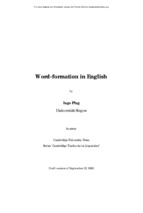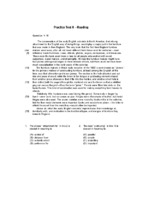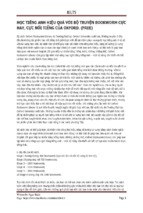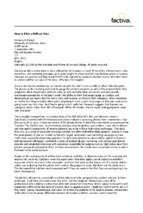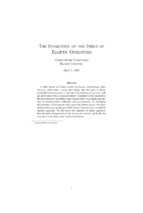THEORY OF
MODERN ELECTRONIC
SEMICONDUCTOR
DEVICES
THEORY OF
MODERN ELECTRONIC
SEMICONDUCTOR
DEVICES
KEVIN F. BRENNAN
APRIL S. BROWN
Georgia Institute of Technology
A Wiley-Interscience Publication
JOHN WILEY & SONS, INC.
"
This book is printed on acid-free paper. !
c 2002 by John Wiley & Sons, Inc., New York. All rights reserved.
Copyright !
Published simultaneously in Canada.
No part of this publication may be reproduced, stored in a retrieval system or transmitted
in any form or by any means, electronic, mechanical, photocopying, recording, scanning or
otherwise, except as permitted under Sections 107 or 108 of the 1976 United States Copyright
Act, without either the prior written permission of the Publisher, or authorization through
payment of the appropriate per-copy fee to the Copyright Clearance Center, 222 Rosewood
Drive, Danvers, MA 01923, (978) 750-8400, fax (978) 750-4744. Requests to the Publisher
for permission should be addressed to the Permissions Department, John Wiley & Sons, Inc.,
605 Third Avenue, New York, NY 10158-0012, (212) 850-6011, fax (212) 850-6008, E-Mail:
[email protected].
For ordering and customer service, call 1-800-CALL-WILEY.
Library of Congress Cataloging-in-Publication Data Is Available
ISBN 0-471-41541-3
Printed in the United States of America
10 9 8 7 6 5 4 3 2 1
To our families,
Lea and Casper
and
Bob, Alex, and John
CONTENTS
PREFACE
xi
1 OVERVIEW OF SEMICONDUCTOR DEVICE TRENDS
1
1.1
1.2
1.3
Moore’s Law and Its Implications
Semiconductor Devices for Telecommunications
Digital Communications
2 SEMICONDUCTOR HETEROSTRUCTURES
2.1
2.2
2.3
2.4
2.5
Formation of Heterostructures
Modulation Doping
Two-Dimensional Subband Transport at Heterointerfaces
Strain and Stress at Heterointerfaces
Perpendicular Transport in Heterostructures and
Superlattices
2.6 Heterojunction Materials Systems: Intrinsic and
Extrinsic Properties
Problems
3 HETEROSTRUCTURE FIELD-EFFECT TRANSISTORS
3.1
3.2
3.3
3.4
Motivation
Basics of Heterostructure Field-Effect Transistors
Simplified Long-Channel Model of a MODFET
Physical Features of Advanced State-of-the-Art MODFETs
1
7
11
14
14
20
25
45
57
66
81
84
84
88
92
104
viii
CONTENTS
3.5 High-Frequency Performance of MODFETs
3.6 Materials Properties and Structure Optimization for HFETs
Problems
4 HETEROSTRUCTURE BIPOLAR TRANSISTORS
4.1 Review of Bipolar Junction Transistors
4.2 Emitter–Base Heterojunction Bipolar Transistors
4.3 Base Transport Dynamics
4.4 Nonstationary Transport Effects and Breakdown
4.5 High-Frequency Performance of HBTs
4.6 Materials Properties and Structure Optimization for HBTs
Problems
5 TRANSFERRED ELECTRON EFFECTS, NEGATIVE
DIFFERENTIAL RESISTANCE, AND DEVICES
5.1 Introduction
5.2 k-Space Transfer
5.3 Real-Space Transfer
5.4 Consequences of NDR in a Semiconductor
5.5 Transferred Electron-Effect Oscillators: Gunn Diodes
5.6 Negative Differential Resistance Transistors
†
5.7 IMPATT Diodes
Problems
6 RESONANT TUNNELING AND DEVICES
6.1
6.2
†
6.3
Physics of Resonant Tunneling: Qualitative Approach
Physics of Resonant Tunneling: Envelope Approximation
Inelastic Phonon Scattering Assisted Tunneling: Hopping
Conduction
6.4 Resonant Tunneling Diodes: High-Frequency Applications
6.5 Resonant Tunneling Diodes: Digital Applications
6.6 Resonant Tunneling Transistors
Problems
7 CMOS: DEVICES AND FUTURE CHALLENGES
†
7.1
7.2
† Optional
Why CMOS?
Basics of Long-Channel MOSFET Operation
material.
115
123
127
130
130
141
152
158
170
183
192
195
195
196
206
213
217
220
222
232
234
234
239
249
258
265
273
276
279
279
288
ix
CONTENTS
7.3 Short-Channel Effects
7.4 Scaling Theory
7.5 Processing Limitations to Continued Miniaturization
Problems
8 BEYOND CMOS: FUTURE APPROACHES TO COMPUTING
HARDWARE
Alternative MOS Device Structures: SOI, Dual-Gate FETs,
and SiGe
8.2 Quantum-Dot Devices and Cellular Automata
8.3 Molecular Computing
8.4 Field-Programmable Gate Arrays and Defect-Tolerant
Computing
8.5 Coulomb Blockade and Single-Electron Transistors
8.6 Quantum Computing
Problems
297
310
314
317
320
8.1
9 MAGNETIC FIELD EFFECTS IN SEMICONDUCTORS
9.1 Landau Levels
9.2 Classical Hall Effect
9.3 Integer Quantum Hall Effect
9.4 Fractional Quantum Hall Effect
9.5 Shubnikov–de Haas Oscillations
Problems
REFERENCES
320
325
340
354
358
369
379
381
381
392
398
407
413
416
419
APPENDIX A:
PHYSICAL CONSTANTS
433
APPENDIX B:
BULK MATERIAL PARAMETERS
435
Table
Table
Table
Table
Table
Table
Table
Table
Table
I: Silicon
II: Ge
III: GaAs
IV: InP
V: InAs
VI: InN
VII: GaN
VIII: SiC
IX: ZnS
435
436
436
437
437
438
438
439
439
x
CONTENTS
Table
Table
Table
Table
Table
Table
X: ZnSe
XI: Alx Ga1#x As
XII: Ga0:47 In0:53 As
XIII: Al0:48 In0:52 As
XIV: Ga0:5 In0:5 P
XV: Hg0:70 Cd0:30 Te
APPENDIX C:
INDEX
HETEROJUNCTION PROPERTIES
440
440
441
441
442
442
443
445
PREFACE
The rapid advancement of the microelectronics industry has continued in
nearly exponential fashion for the past 30 years. Continuous progress has
been made in miniaturizing integrated circuits, thus increasing circuit density and complexity at reduced cost. These circumstances have fomented
the continuous expansion of computing capability that has driven the modern information age. Explosive growth is occurring in computing technology
and communications, driven mainly by the advancements in semiconductor
hardware. Continued growth in these areas depends on continued progress
in microelectronics.
At this writing, critical device dimensions for commercial products are already approaching 0.1 ¹m. Continued miniaturization much beyond 0.1-¹m
feature sizes presents myriad problems in device performance, fabrication,
and reliability. The question is, then, will microelectronics technology continue in the same manner as in the past? Can continued miniaturization and
its concomitant increase in circuit speed and complexity be maintained using
current CMOS technology, or will new, radically different device structures
need to be invented?
The growth in wireless and optical communications systems has closely followed the exponential growth in computing technology. The need not only to
process but also to transfer large packets of electronic data rapidly via the
Internet, wireless systems, and telephony is growing at a brisk rate, placing ever increasing demands on the bandwidth of these systems. Hardware
used in these systems must thus be able to operate at ever higher frequencies and output power levels. Owing to the inherently higher mobility of many
xii
PREFACE
compound semiconductor materials compared to silicon, currently most highfrequency electronics incorporate compound semiconductors such as GaAs
and InP. Record-setting frequency performance at high power levels is invariably accomplished using either heterostructure field-effect or heterostructure
bipolar transistors. What, though, are the physical features that limit the performance of these devices? What are their limits of performance? What
alternatives can be utilized for high-frequency-device operation?
Device dimensions are now well within the range in which quantum mechanical effects become apparent and even in some instances dominant. What
quantum mechanical phenomena are important in current and future semiconductor devices? How do these effects alter device performance? Can
nanoelectronic devices be constructed that function principally according to
quantum mechanical physics that can provide important functionality? How
will these devices behave?
The purpose of this book is to examine many of the questions raised above.
Specifically, we discuss the behavior of heterostructure devices for communications systems (Chapters 2 to 4), quantum phenomena that appear
in miniaturized structures and new nanoelectronic device types that exploit
these effects (Chapters 5, 6, and 9), and finally, the challenges faced by continued miniaturization of CMOS devices and futuristic alternatives (Chapters
7 and 8). We believe that this is the first textbook to address these issues
in a comprehensive manner. Our aim is to provide an up-to-date and extended discussion of some of the most important emerging devices and
trends in semiconductor devices. The book can be used as a textbook for
a graduate-level course in electrical engineering, physics, or materials science. Nevertheless, the content will appeal to practicing professionals. It is
suggested that the reader be familiar with semiconductor devices at the level
of the books by Streetman or Pierret. In addition, much of the basic science
that underlies the workings of the devices treated in this text is discussed in
detail in the book by Brennan, The Physics of Semiconductors with Applications to Optoelectronic Devices, Cambridge University Press, 1999. The
reader will find it useful to refer to this book for background material that can
supplement his or her knowledge aiding in the comprehension of the current
book.
The book contains nine chapters in total. The first chapter provides an
overview of emerging trends in compound semiconductors and computing
technology. We have tried to focus the book on the three emerging areas
discussed above: telecommunications, quantum structures, and challenges
and alternatives to CMOS technology. The balance of the book examines
these three issues in detail. There are sections throughout that can be omitted without loss of continuity. These sections are marked with a dagger. We
end the book with a chapter on magnetic field effects in semiconductors.
It is our belief that although few devices currently exploit magnetic field effects, the unusual physical properties of reduced dimensional systems when
exposed to magnetic fields are of keen interest and may point out new di-
PREFACE
xiii
rections in semiconductor device technology. Again, the instructor may elect
to skip Chapter 9 completely without compromising the main focus of the
book.
From a pedagogic point of view, we have developed the book from class
notes we have written for a one-semester graduate-level course given in
the School of Electrical and Computer Engineering at the Georgia Institute
of Technology. This course is generally taught in the spring semester following a preparatory course taught in the fall. Most students first study the
fall semester course, which is based on the first nine chapters of the book
by Brennan, The Physics of Semiconductors with Applications to Optoelectronic Devices. Nevertheless, the present book can be used independent of
a preparatory course, using the book by Brennan as supplemental reference
material. The present book is fully self-contained and refers the reader to
Brennan’s book only when needed for background material. Typically, we
teach Chapters 2 to 8 in the current book, omitting the optional (Sections
2.5, 5.7, 6.3, and 7.1). The students are asked to write a term paper in the
course following up in detail on one topic. In addition, homework problems
and a midterm and final examinations are given. The reader is invited to
visit the book Web site at www.ece.gatech.edu/research/labs/comp elec for
updates and supplemental information. At the book Web site a passwordprotected solutions manual is available for instructors, along with sample
examinations and their solutions.
We would like to thank our many colleagues and students at Georgia Tech for
their interest and helpful insight. Specifically, we are deeply grateful to Dr. Joe
Haralson II, who assisted greatly in the design of the cover and in revising
many of the figures used throughout. We are also grateful to Tsung-Hsing
Yu, Dr. Maziar Farahmand, Louis Tirino, Mike Weber, and Changhyun Yi for
their help on technical and mechanical aspects of manuscript preparation.
Additionally, we thank Mike Weber and Louis Tirino for setting up the book
Web site. Finally, we thank Dr. Dan Tsui of Princeton University, Dr. Wolfgang
Porod of Notre Dame University, Dr. Mark Kastner of MIT, Dr. Stan Williams
of Hewlett-Packard Laboratories, and Dr. Paul Ruden of the University of
Minnesota at Minneapolis for granting permission to reproduce some of their
work in this book and for helpful comments in its construction.
Finally, both of us would like to thank our families and friends for their enduring support and patience.
Atlanta
November 2000
Kevin F. Brennan
April S. Brown
CHAPTER 1
Overview of Semiconductor Device Trends
The dawn of the third millennium coincides with what has often been referred
to as the information age. The rapid exchange of information in its various
formats has become one of the most important activities of our modern world.
Shannon’s early recognition that information in its most basic form can be
reduced to a series of bits has lead to a vast infrastructure devoted to the
rapid and efficient transfer of information in bit form. The technical developments that underlie this infrastructure result from a blending of computing
and telecommunications. Basic to these industries is semiconductor hardware,
which provides the essential tools for information processing, transfer, and
display.
1.1 MOORE’S LAW AND ITS IMPLICATIONS
The integrated circuit is the fundamental building block of modern digital
electronics and computing. The rapid expansion of computing capability is
derived mainly from successive improvements in device miniaturization and
the concomitant increase in device density and circuit complexity on a single
chip. Functionality per chip has grown in accordance with Moore’s law, an
historical observation made by Intel executive Gordon Moore. Moore’s law
states that functionality as measured by the number of transistors and bits
doubles every 1.5 to 2 years. As can be seen from Figure 1.1.1, the number
of transistors on a silicon chip has followed an exponential dependence since
the late 1960s. This in turn has led to dramatic improvements in computing
capability, leading the consumer to expect ever better products at reduced cost.
1
2
OVERVIEW OF SEMICONDUCTOR DEVICE TRENDS
FIGURE 1.1.1 Number of transistors per chip as a function of year, including the
names of the processors. The dashed line shows projections to 2010. The exponential
growth reflected by this graph is what is commonly referred to as Moore’s law. (Data
from Birnbaum and Williams, 2000.)
One of the questions that this book addresses is: Is there a limit to Moore’s
law? Can integrated-circuit complexity continue to grow exponentially into
the twenty-first century, or are their insurmountable technical or economic
challenges that will derail this progress?
The two prominent technical drivers of the semiconductor industry are dynamic random access memory (DRAM), and microprocessors. Historically,
DRAM technology developed at a faster pace than microprocessor technology. However, from the late 1990s microprocessors have become at least an
equal partner to DRAMs in driving semiconductor device refinement. In many
instances, microprocessor units (MPUs), have become the major driver of
semiconductor technology. There are different performance criteria for these
two major product families. The major concerns for DRAMs are cost and
memory capacity. The usual metric applied to DRAMs is half-pitch, which is
defined as essentially the separation between adjacent memory cells on the
chip. Consequently, minimization of the area of each memory cell to provide greater memory density is the primary development focus for DRAMs.
Cost and performance also drive microprocessor development, but the key parameters in this case are gate length and the number of interconnect layers.
The maintainence of Moore’s law requires, then, aggressive reduction in gate
length as well as in DRAM cell area.
The semiconductor industry has tracked the technology trends of both
DRAM and microprocessor technology and established technology road maps
to project where the technology will be in subsequent years. Such road maps
provide the industry with a rough guide to the technology trends expected.
Below we discuss some of the implications of these trends and examine how
they affect Moore’s law.
MOORE’S LAW AND ITS IMPLICATIONS
3
FIGURE 1.1.2 Fabrication plant cost as a function of year. Notice the tremendous
cost projected by the year 2010. (Data from Birnbaum and Williams, 2000.)
Let us first consider economic challenges to the continuation of Moore’s
law. There is a second law attributed to Moore, Moore’s second law, which
examines the economic issues related to integrated-circuit chip manufacture.
According to Moore’s second law, the cost of fabrication facilities needed to
manufacture each new generation of integrated circuits increases by a factor
of 2 every three years. Extrapolating from fabrication plant costs of about $1
billion in 1995, Figure 1.1.2 shows that the cost of a fabrication plant in 2010
could reach about $50 billion. That a single company or even a consortium
of companies could bear such an enormous cost is highly doubtful. Even if
a worldwide consortium of semiconductor industries agreed to share such a
cost, continuing to do so for future generations would certainly not be feasible. Therefore, it is likely that the economics of manufacturing will strongly
influence the growth of the integrated-circuit industry in the near future.
Aside from the economic issues faced by continued miniaturization, several
daunting technical challenges threaten continued progress in miniaturization
of integrated circuits in accordance with Moore’s law. As discussed in detail
in Chapter 7, several technical issues threaten continued exponential growth
of integrated-circuit complexity. Generally, these concerns can be classified as
either physical or practical. By physical challenges we mean problems encountered in the physical operation of a device under continued miniaturization.
Practical challenges arise from the actual fabrication and manufacture of these
miniaturized devices. Among the practical challenges are lithography, gate
oxide thickness reduction, and forming interconnects to each device. Physical
operational problems encountered by continued miniaturization of devices include threshold voltage shifts, random fluctuation in the dopants, short-channel
effects, and high-field effects. Any one or a combination of these effects could
threaten continued progress of Moore’s law. We examine these effects in detail
in Chapter 7.
4
OVERVIEW OF SEMICONDUCTOR DEVICE TRENDS
FIGURE 1.1.3 Number of chip components as a function of device feature size. Both
the historical trend and projected values according to the Semiconductor Institute of
America (SIA) road map are shown. (Data from Birnbaum and Williams, 2000.)
Figure 1.1.3 shows how the number of chip components scales with the
on-chip feature size. As can be seen, to maintain the historical trend in the
near future, device feature sizes will need to be scaled significantly below
0:1 ¹m. However, doing so requires overcoming many of the challenges listed
above. At the time of this writing, strategies for overcoming the physical and
practical challenges to further miniaturization are not known.
In addition to the practical and physical challenges to continued miniaturization, there are other issues that may thwart further progress. Formidable
challenges arise in design, testing, and packaging integrated circuits containing billions of transistors. For example, testing a chip containing billions of
transistors that operates at gigabit speeds is presently not possible. It is not sufficient that the chip contain billions of devices and operates at gigabit speeds.
Just as important is the ability to extract signals from the transistors within the
chip at gigahertz frequencies. Therefore, new packaging schemes will need to
be developed to ensure that chip output progresses along with the chip itself.
Although there are many practical and physical challenges that may thwart
further reduction of integrated circuits, progress may still occur through either evolutionary or revolutionary advancements. By evolutionary, we mean
continued progress in device reduction through progressive refinements in the
main integrated-circuit technology itself, complementary metal-oxide semiconductor (CMOS), technology. In Chapter 7 we examine several evolutionary
technologies that could potentially extend CMOS in accordance with Moore’s
law. Alternatively, revolutionary technologies that go well beyond conventional
CMOS may be required to continue progress in miniaturization. In Chapter
8 we examine several leading candidate technologies that may form the basis of computing hardware in the future. However, before anyone begins to
invest and develop these alternative technologies aggressively, it is first nec-
5
MOORE’S LAW AND ITS IMPLICATIONS
essary to examine just how much better computing hardware can be made to
be. It would be very unwise to pursue an expensive revolutionary technology
aggressively if only marginal performance improvements can be made.
To this end, it is important to ask: What are the fundamental limits to computation, if any? Can these limits be quantified? Knowledge of the ultimate
limits that the laws of physics place on computation, coupled with where
CMOS technology is at present, clearly enable us to assess what more can be
done and whether such advancements warrant development. Rolf Landauer
and Richard Feynman pondered these questions in the late 1950s. They considered independently what the thermodynamic limits are to computing after
recognizing that information could be treated as a physical entity and could
thus be quantified.
Work by Lloyd (2000) has examined in detail the physical limits to computation. To that end, it is useful to determine the maximum speed of a logical
operation. To perform an elementary logic operation in a certain time, a minimum amount of energy is required. The minimum energy required to perform
a logic operation in time ¢t is given by Lloyd (2000) as
E"
¼¹
2¢t
1.1.1
Therefore, if a computer has energy E available to it for computation, it can
perform a maximum number of logical operations N per second given as
N=
2E
¼¹
1.1.2
It is important to recognize that the foregoing limit applies to both serial and
parallel processing. The computational limit is independent of the computer
architecture. The total number of computations per second is the same whether
one chooses to spend all the available energy to do serial computation faster or
spread the energy out to do many calculations at once but with each calculation
taking more time.
How do present computers compare to this ultimate speed limit? If one had
an ideal computer, one in which all its mass could be transformed into computational energy, the limits imposed by Eqs. 1.1.1 and 1.1.2 would lead to
very high computational speeds. Lloyd (2000) has estimated that a 1-kg computer all of whose mass–energy could be used for computation could perform
about 1050 operations per second. A modern computer falls far short of this
rate mainly because (1) very little of its mass–energy is used in performing
logic operations, and (2) many electrons are used to encode 1 bit. In modern
computers, anywhere from 106 to 109 electrons are used to encode a “1.”
In principle, only one electron is needed to encode a “1.” As we will see in
Chapter 8, single-electron transistors have been developed that require only
one electron for charging and storage of a bit.
6
OVERVIEW OF SEMICONDUCTOR DEVICE TRENDS
In addition to the limit placed on the computational speed of a logical
operation, thermodynamics limits the number of bits that can be processed
using a specific amount of energy in a given volume. The amount of available
energy limits the computational rate, while the entropy limits the amount of
information that can be stored and manipulated. The classical entropy is related
to the multiplicity of states as (Brennan, 1999, Sec. 5.3)
S = kB ¾ = kB ln g
1.1.3
where kB is Boltzmann’s constant, ¾ the entropy, S the conventional entropy,
and g the multiplicity function. For a two-level system of m components,
the multiplicity function g is equal to 2m . Such a system can store m bits of
information. Thus the number of bits m that can be stored in the system can
be related to the entropy as
S
m=
1.1.4
kB ln 2
Combining Eqs. 1.1.2 and 1.1.4, the maximum number of logical operations
per second per bit can be found as
operations 2E kB ln 2 2EkB ln 2
=
=
¼¹ S
¼¹S
bit-second
1.1.5
Recognizing that the temperature T is given as (Brennan, 1999, Sec. 5.3)
dS
1
=
T dE
1.1.6
the maximum number of operations per bit per second can be approximated
as
operations kB T
#
1.1.7
¹
bit-second
Thus the temperature limits the maximum number of operations per bit per
second. A very high temperature is needed to maximize the number of operations. High-temperature operation is undesirable in a practical computing
system.
In summary, the thermodynamic limit of a nonreversible computer (one in
which there exists dissipation of energy during computation) is many orders of
magnitude higher than the estimated upper limit of CMOS circuitry. Based on
these results, it is clear that there remains the possibility of a huge improvement
in computing capability with further miniaturization. Although different paths
may need to be taken from the current one for CMOS, there remains the strong
possibility that dramatic improvement in computing hardware can be realized
with increased miniaturization. Part of the focus of this book is to examine
what technologies can be harnessed to provide further miniaturization.
SEMICONDUCTOR DEVICES FOR TELECOMMUNICATIONS
7
1.2 SEMICONDUCTOR DEVICES FOR TELECOMMUNICATIONS
Although the largest part of the semiconductor industry is devoted to silicon integrated-circuit technology and CMOS in particular, the rapid growth
of the telecommunications industry has stimulated significant growth in a different part of the semiconductor industry: compound semiconductors. The
total worldwide semiconductor market has exceeded $200 billion in sales in
the year 2000. Only about $15 billion of this amount can be attributed to
compound semiconductor products. Nevertheless, compound semiconductors
have undergone a dramatic increase in sales over the past decade. From the
early to late 1990s, shipment of compound semiconductor device products
has increased over fourfold. Much of the rapid growth in compound semiconductor products has occurred in telecommunications, owing to expansion in
both wireless and wired fiber-optic systems. Projections indicate that due to
the rapid growth of the telecommunications industry, the sale of compound
semiconductor products will grow more rapidly than that of silicon-based
semiconductor products.
The most important compound semiconductor products used in fiber-optic
networks are optoelectronic devices, particularly lasers and detectors. Semiconductor lasers are made exclusively from compound semiconductors since
these materials have direct bandgaps and can thus be made to lase. In contrast, silicon is an indirect-gap semiconductor and currently cannot lase. In
addition, direct-gap materials make more efficient photodetectors, at least for
radiation with wavelengths near the bandgap. For these reasons, the optoelectronic component industry utilizes primarily compound semiconductors.
Although the overall market for optoelectronic devices is small compared to
that for CMOS, it is still substantial. Revenue in 2000 for optical components
exceeded $10 billion. Forecasts predict that the worldwide optical component
market will exceed $19 billion by 2003, just about doubling in three to four
years. In this book we restrict our discussion to electronic devices and do not
consider optoelectronic devices. The interested reader is referred to the book
by Brennan (1999) for a discussion of optoelectronic devices.
The compound semiconductor industry developed from military electronics needs for microwave and millimeter-wave systems. For these applications,
including radar and satellite-based communications, cost was considered a
secondary metric to performance. With the advent of microwave commercial electronics, the metrics have changed. Figure 1.2.1 shows the increase
in frequency for commercial electronics over the past two decades. Figure
1.2.2 shows the progression of technology drivers and insertion points for microwave electronics. The movement toward commercial electronics has significantly reduced the cycle time, placed a much stronger emphasis on ruggedness
or reliability, and broadened the scope of relevant and specific performance
criteria.
Advances in epitaxy, the process technique for producing atomically smooth
heterojunctions, have, in part, enabled their use in commercial products. Mo-
8
OVERVIEW OF SEMICONDUCTOR DEVICE TRENDS
FIGURE 1.2.1 Advancement of frequency for commercial electronics. Progress up
in frequency occurs at a rate of approximately 1 octave/decade. (Reprinted with permission from Golio, 2000.)
FIGURE 1.2.2 Progression of technology drivers and insertion points for microwave
electronics. (Reprinted with permission from Golio, 2000.)
lecular beam epitaxy (MBE) and metal-organic chemical vapor deposition
(MOCVD) evolved primarily as laboratory tools for physics experiments and
the production of new, exotic materials. Today, both techniques have been
scaled for multiwafer growth and are being used for the commercial production of heterojunction-based optical and electronic devices. The size of GaAs
and InP wafers has also affected manufacturing and cost, due in part to the


